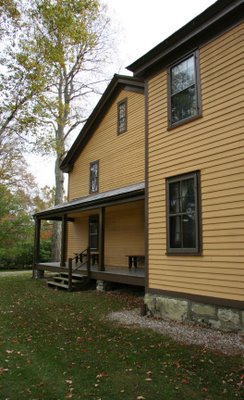

Death is just a place I have yet to visit. Unfortunately, the taking of photographs is strictly prohibited.
 Drawing found on the simple playground (swing set, two outhouses) of one-room Amish schoolhouse, Maxatawny Township, near Kutztown, Berks County, Pa.
Drawing found on the simple playground (swing set, two outhouses) of one-room Amish schoolhouse, Maxatawny Township, near Kutztown, Berks County, Pa. 

 On the Palisades Interstate Parkway heading up to the bridge, there are several scenic lookout points. This one offers a view south toward the George Washington Bridge and the Manhattan skyline.
On the Palisades Interstate Parkway heading up to the bridge, there are several scenic lookout points. This one offers a view south toward the George Washington Bridge and the Manhattan skyline. Detail of the piazza, or porch, that Melville ordered built after he bought the house. The views from the piazza of Mt. Greylock, the highest point in Massachusetts, inspired him, and he loved to spend long hours sitting in his rocking chair, taking in the scenery. It was for this piazza that he named a collection of his shorter works.
Detail of the piazza, or porch, that Melville ordered built after he bought the house. The views from the piazza of Mt. Greylock, the highest point in Massachusetts, inspired him, and he loved to spend long hours sitting in his rocking chair, taking in the scenery. It was for this piazza that he named a collection of his shorter works. Mt. Greylock from the piazza
Mt. Greylock from the piazza Mt. Greylock from the window of Melville's second-floor study, the room in which he wrote "Moby-Dick." It is said that the shape of the distant mountain reminded Melville of a menacing whale and served as inspiration while he composed his masterpiece. The book was blasted by the critics, and Melville's career was ruined. It was only in the mid-1920s that scholars began to reassess this arguably greatest of American novels and accord it its due place in our literature.
Mt. Greylock from the window of Melville's second-floor study, the room in which he wrote "Moby-Dick." It is said that the shape of the distant mountain reminded Melville of a menacing whale and served as inspiration while he composed his masterpiece. The book was blasted by the critics, and Melville's career was ruined. It was only in the mid-1920s that scholars began to reassess this arguably greatest of American novels and accord it its due place in our literature. Melville's barn. Inside, he and close friend and neighbor Nathaniel Hawthorne would chat for hours on end, uninterrupted by Melville's bustling household of children and extended family.
Melville's barn. Inside, he and close friend and neighbor Nathaniel Hawthorne would chat for hours on end, uninterrupted by Melville's bustling household of children and extended family.


